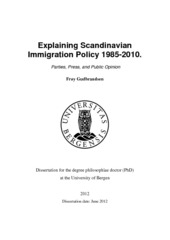| dc.contributor.author | Gudbrandsen, Frøy | eng |
| dc.date.accessioned | 2012-12-13T12:12:57Z | |
| dc.date.available | 2012-12-13T12:12:57Z | |
| dc.date.issued | 2012-11-30 | eng |
| dc.identifier.isbn | 978-82-308-2147-3 (print version) | |
| dc.identifier.uri | https://hdl.handle.net/1956/6231 | |
| dc.description.abstract | This thesis is concerned with explaining Scandinavian immigration policy from 1985- 2010. The overarching research question – what determines immigration and immigration policy in Scandinavia – is approached from three different angles. The articles all study immigration to Scandinavia, but emphasise different potential determinants: political parties, the press and public opinion. The thesis articles thus apply different theoretical approaches, such as ‘partisan theory’ and ‘government responsiveness theory’. Together, the articles cover a 25 year time period, and they encompass all three Scandinavian countries. One article also look into the impact of sending country determinants, and include data on 143 sending countries. The thesis studies asylum and family immigration, two out of the three major immigration types to Scandinavia. Despite increased international co-operation on immigration, the findings of the articles also suggest that the national democracies are still central in immigration policy-making. Political parties are found to influence asylum inflows, and asylum policy changes in Scandinavia also appear to be in accordance with public policy changes. However, the press is not found to be a central actor in the making of family immigration policy neither in Norway nor Sweden. The thesis has a state centred approach, but acknowledging the influence of international actors and processes in national immigration policy-making, the limits to national democratic control is discussed in the synopsis chapter. One of the articles also explicitly tests the relative importance of national and international determinants of immigration. The thesis primarily uses quantitative methods: panel regression analysis, multinomial logistic regression and ordered logistic regression. However, all articles also include elements of qualitative analyses. This goes in particular for the content analyses of party manifestoes and newspaper articles in two of the articles. Thus the data material analysed includes, amongst other, immigration flow data, legislative and regulative policy changes, and press coverage. The first article, “Partisan influence on immigration: The case of Norway,” tests the relevance of ‘the parties matter hypothesis’ for the field of immigration, by looking into the importance of parties in government for asylum grants in Norway. The article first develops hypotheses regarding what effect the different government types could be expected to have on immigration, based on statements in party manifestoes and newspaper articles. These are tested in a panel regression analysis of the number of asylum admissions from each sending country from 1985-2005. Controlled for a number of sending country variables and unemployment in Norway, conservative governments are found to significantly reduce refugee residence permits granted. The second article, “Is the Press a Political Actor in Family Immigration Policy?”, studies the coverage of family immigration policy in Norwegian and Swedish newspapers, to understand the role of the press in the family immigration policymaking. The analysis of the press coverage reveals clear differences in the coverage in the two countries. Most distinctively, the Norwegian press has to a larger extent put family immigration policy on the media agenda independently on the political agenda, whereas the Swedish press primarily has reported on government policy after decisions are made. However, in neither country the press coverage appears to be followed by policy changes. The third article, “Do Asylum Policies Respond to Public Opinion?”, builds on government responsiveness theory, which suggests citizen preferences may impact on government policies not only through elections, but also in-between elections as governments pay attention to public opinion. The article looks into the relationship between public preferences on refugee immigration and legislative and regulative changes to asylum policy. Time series data on refugee immigration attitudes from Denmark, Norway and Sweden are analysed, and the ordered logistic regression results shows that restrictive public opinion significantly increases probability for asylum restrictions. Other determinants previously found to influence asylum policy, such as government colour and radical right party support, are controlled. | en_US |
| dc.language.iso | eng | eng |
| dc.publisher | The University of Bergen | eng |
| dc.relation.haspart | Paper I: Gudbrandsen, F. (2010): “Partisan Influence on Immigration. The case of Norway”, Scandinavian Political Studies, 33(3), 248-270. Full text not available in BORA due to publisher restrictions. The published version is available at: <a href="http://dx.doi.org/10.1111/j.1467-9477.2010.00250.x" target="blank"> http://dx.doi.org/10.1111/j.1467-9477.2010.00250.x</a> | eng |
| dc.relation.haspart | Paper II: Gudbrandsen, F. (2011): “Er pressen en politisk aktør i familieinnvandringspolitikken?”, Nytt Norsk Tidsskrift, 4/2011, 370-383. Full text not available in BORA due to publisher restrictions. The published version is available at: <a href="http://www.idunn.no/ts/nnt/2011/04/art03" target="blank">http://www.idunn.no/ts/nnt/2011/04/art03</a> | eng |
| dc.relation.haspart | Paper III: Gudbrandsen, F. (2012): «Do Asylum Policies Respond to Public Preferences?” Forthcoming in “The Discourses and Politics of Migration in Europe”, eds. Korkut, Umut; Bucken-Knapp, Gregg, McGarry, Aidan, Hinnfors, Jonas, and Drake, Helen. New York: Palgrave/NYU Studies in Europe in Transition. Prospective date: 2013. Full text not available in BORA due to publisher restrictions. | eng |
| dc.title | Explaining Scandinavian Immigration Policy 1985-2010. Parties, Press, and Public Opinion | eng |
| dc.type | Doctoral thesis | en_US |
| dc.rights.holder | Copyright the author. All rights reserved | en_US |
